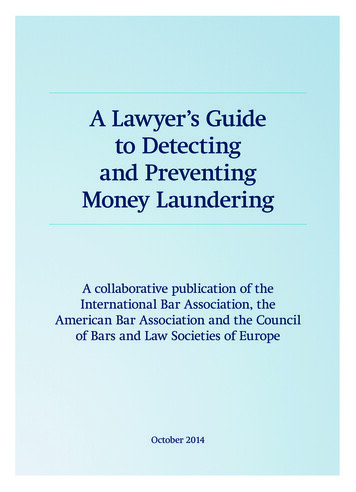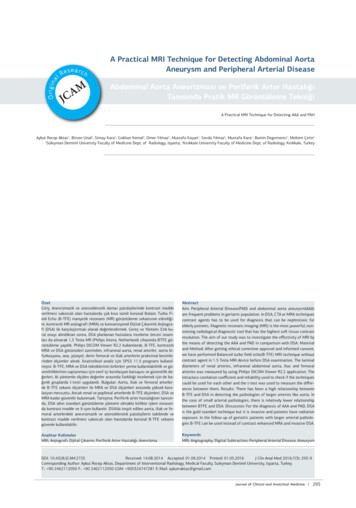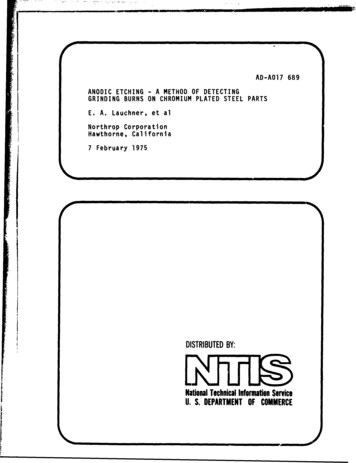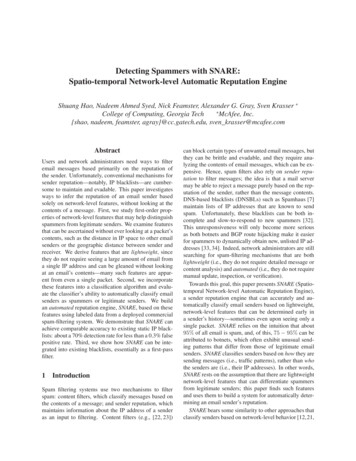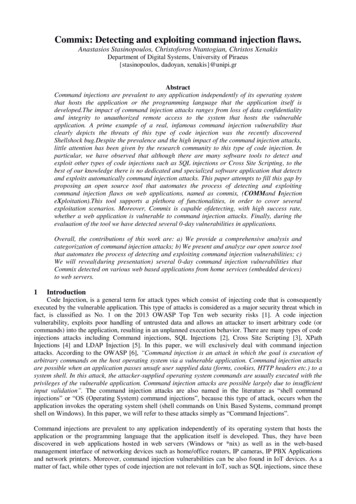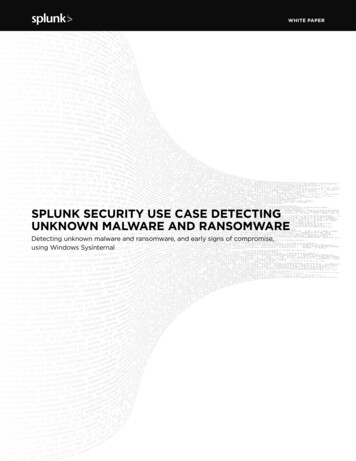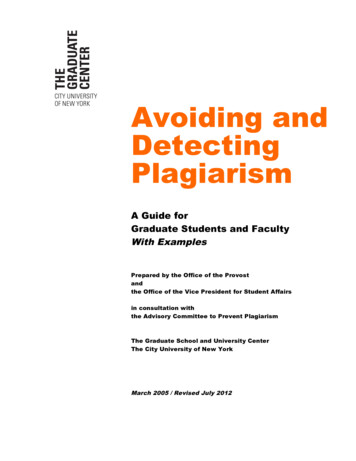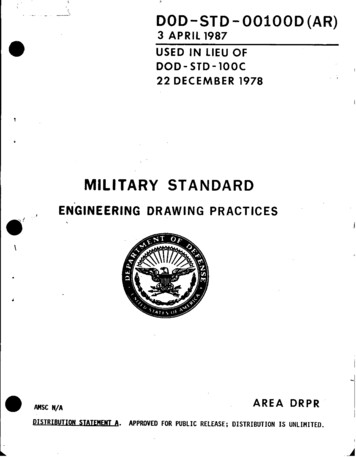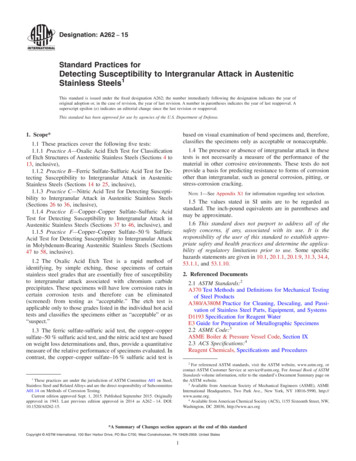
Transcription
Designation: A262 15Standard Practices forDetecting Susceptibility to Intergranular Attack in AusteniticStainless Steels1This standard is issued under the fixed designation A262; the number immediately following the designation indicates the year oforiginal adoption or, in the case of revision, the year of last revision. A number in parentheses indicates the year of last reapproval. Asuperscript epsilon ( ) indicates an editorial change since the last revision or reapproval.This standard has been approved for use by agencies of the U.S. Department of Defense.based on visual examination of bend specimens and, therefore,classifies the specimens only as acceptable or nonacceptable.1. Scope*1.1 These practices cover the following five tests:1.1.1 Practice A—Oxalic Acid Etch Test for Classificationof Etch Structures of Austenitic Stainless Steels (Sections 4 to13, inclusive),1.1.2 Practice B—Ferric Sulfate-Sulfuric Acid Test for Detecting Susceptibility to Intergranular Attack in AusteniticStainless Steels (Sections 14 to 25, inclusive),1.1.3 Practice C—Nitric Acid Test for Detecting Susceptibility to Intergranular Attack in Austenitic Stainless Steels(Sections 26 to 36, inclusive),1.1.4 Practice E—Copper–Copper Sulfate–Sulfuric AcidTest for Detecting Susceptibility to Intergranular Attack inAustenitic Stainless Steels (Sections 37 to 46, inclusive), and1.1.5 Practice F—Copper–Copper Sulfate–50 % SulfuricAcid Test for Detecting Susceptibility to Intergranular Attackin Molybdenum-Bearing Austenitic Stainless Steels (Sections47 to 58, inclusive).1.4 The presence or absence of intergranular attack in thesetests is not necessarily a measure of the performance of thematerial in other corrosive environments. These tests do notprovide a basis for predicting resistance to forms of corrosionother than intergranular, such as general corrosion, pitting, orstress-corrosion cracking.NOTE 1—See Appendix X1 for information regarding test selection.1.5 The values stated in SI units are to be regarded asstandard. The inch-pound equivalents are in parentheses andmay be approximate.1.6 This standard does not purport to address all of thesafety concerns, if any, associated with its use. It is theresponsibility of the user of this standard to establish appropriate safety and health practices and determine the applicability of regulatory limitations prior to use. Some specifichazards statements are given in 10.1, 20.1.1, 20.1.9, 31.3, 34.4,53.1.1, and 53.1.10.1.2 The Oxalic Acid Etch Test is a rapid method ofidentifying, by simple etching, those specimens of certainstainless steel grades that are essentially free of susceptibilityto intergranular attack associated with chromium carbideprecipitates. These specimens will have low corrosion rates incertain corrosion tests and therefore can be eliminated(screened) from testing as “acceptable.” The etch test isapplicable only to those grades listed in the individual hot acidtests and classifies the specimens either as “acceptable” or as“suspect.”2. Referenced Documents2.1 ASTM Standards:2A370 Test Methods and Definitions for Mechanical Testingof Steel ProductsA380/A380M Practice for Cleaning, Descaling, and Passivation of Stainless Steel Parts, Equipment, and SystemsD1193 Specification for Reagent WaterE3 Guide for Preparation of Metallographic Specimens2.2 ASME Code:3ASME Boiler & Pressure Vessel Code, Section IX2.3 ACS Specifications:4Reagent Chemicals, Specifications and Procedures1.3 The ferric sulfate-sulfuric acid test, the copper–coppersulfate–50 % sulfuric acid test, and the nitric acid test are basedon weight loss determinations and, thus, provide a quantitativemeasure of the relative performance of specimens evaluated. Incontrast, the copper–copper sulfate–16 % sulfuric acid test is2For referenced ASTM standards, visit the ASTM website, www.astm.org, orcontact ASTM Customer Service at service@astm.org. For Annual Book of ASTMStandards volume information, refer to the standard’s Document Summary page onthe ASTM website.3Available from American Society of Mechanical Engineers (ASME), ASMEInternational Headquarters, Two Park Ave., New York, NY 10016-5990, http://www.asme.org.4Available from American Chemical Society (ACS), 1155 Sixteenth Street, NW,Washington, DC 20036, http://www.acs.org1These practices are under the jurisdiction of ASTM Committee A01 on Steel,Stainless Steel and Related Alloys and are the direct responsibility of SubcommitteeA01.14 on Methods of Corrosion Testing.Current edition approved Sept. 1, 2015. Published September 2015. Originallyapproved in 1943. Last previous edition approved in 2014 as A262 – 14. DOI:10.1520/A0262-15.*A Summary of Changes section appears at the end of this standardCopyright ASTM International, 100 Barr Harbor Drive, PO Box C700, West Conshohocken, PA 19428-2959. United States1
A262 152.4 ISO Standard:5ISO 3651-2 Determination of Resistance to IntergranularCorrosion of Stainless Steels—Part 2: Ferritic, Austenitic,and Ferritic-Austenitic (Duplex) Stainless Steels—Corrosion Test in Media Containing Sulfuric Acid4.5 There are two classes of specimens to be considered:base metal, and process-affected metal.4.5.1 Process-affected metal contains any condition thataffects the corrosion properties of the material in a non-uniformway, such as (but not limited to) welds; carburized. nitrided, oroxidized surfaces; mechanical deformation; and areas affectedby heat. Base metal has none of these conditions.4.5.2 Because Practices B, C, and F involve immersing theentire specimen and averaging the mass loss over the totalspecimen area, and because welding, carburization, mechanicaldeformation, and the like affect only part of a specimen, thepresence of process-affected metal in a specimen can affect thetest result in an unpredictable way depending on the proportions of the area affected.4.5.3 If the presence of these or other localized conditions isa concern to the purchaser, then tests that do not average themass loss over the total specimen surface area, such as PracticeA, the Oxalic Acid Etch Test, or Practice E, the Copper–CopperSulfate–Sulfuric Acid Test for Detecting Susceptibility toIntergranular Attack in Austenitic Stainless Steels, should beconsidered.3. Purity of Reagents3.1 Purity of Reagents—Reagent grade chemicals shall beused in all tests. Unless otherwise indicated, it is intended thatall reagents conform to the specifications of the Committee onAnalytical Reagents of the American Chemical Society6 wheresuch specifications are available. Other grades may be used,provided it is first ascertained that the reagent is of sufficientlyhigh purity to permit its use without lessening the accuracy ofthe test result.3.2 Purity of Water—Unless otherwise indicated, referencesto water shall be understood to mean reagent water as definedby Type IV of Specification D1193.PRACTICE A—OXALIC ACID ETCH TEST FORCLASSIFICATION OF ETCH STRUCTURES OFAUSTENITIC STAINLESS STEELS (1)75. Summary of Practice4. Scope5.1 A specimen representative of the material to be evaluated is polished to a specified finish and over-etched usingoxalic acid electrolytically. The etched specimen is thenexamined using a metallurgical microscope. The etched structure is compared with reference photographs to determinewhether the material is acceptable or suspect. Suspect materialis then subjected to the specified hot acid immersion test.4.1 The Oxalic Acid Etch Test is used for acceptance ofwrought or cast austenitic stainless steel material but not forrejection of material. Use of A262 Practice A as a stand-alonetest may reject material that the applicable hot acid test wouldfind acceptable; such use is outside the scope of this practice.4.2 This test is intended to be used in connection with otherevaluation tests described in these practices to provide a rapidmethod for identifying qualitatively those specimens that arecertain to be free of susceptibility to rapid intergranular attackin these other tests. Such specimens have low corrosion rates inthe various hot acid tests which require from 15 to 240 h ofexposure. These specimens are identified by means of theiretch structures, which are classified according to the criteriagiven in Section 11.6. Significance and Use6.1 Use of the etch test allows rapid acceptance of specificlots of material without the need to perform time-consumingand costly hot acid immersion tests on those lots.7. Apparatus7.1 Etching Cell:7.1.1 An etching cell may be assembled using componentsas described in this section. Alternatively, a commercialelectropolisher/etcher (as used for metallographic samplepreparation) may be used for small specimens provided thecurrent density requirement of 10.2 is met.7.1.2 Source of Direct Current—Battery, generator, or rectifier capable of supplying about 15 V and 20 A.7.1.3 Ammeter—For direct current; used to measure thecurrent on the specimen to be etched.7.1.4 Variable Resistance—Used to control the current onthe specimen to be etched.7.1.5 Cathode—A stainless steel container, for example, a1-L (1-qt) stainless steel beaker.7.1.5.1 Alternate Cathode—A piece of flat stainless steel atleast as large as the specimen surface.7.1.6 Electrical Clamp—To hold the specimen to be etchedand to complete the electrical circuit between the specimen andthe power source such that the specimen is the anode of thecell.4.3 The Oxalic Acid Etch Test may be used to screenspecimens intended for testing in Practice B—Ferric SulfateSulfuric Acid Test, Practice C—Nitric Acid Test, PracticeE—Copper-Copper Sulfate–16 % Sulfuric Acid Test, and Practice F—Copper-Copper Sulfate–50 % Sulfuric Acid Test.4.4 Each of these other practices contains a table showingwhich classifications of etch structures on a given stainlesssteel grade are equivalent to acceptable or suspect performancein that particular test. Specimens having acceptable etchstructures need not be subjected to the hot acid test. Specimenshaving suspect etch structures must be tested in the specifiedhot acid solution.5Available from International Organization for Standardization (ISO), 1, ch. dela Voie-Creuse, CP 56, CH-1211 Geneva 20, Switzerland, http://www.iso.org.6For suggestions on the testing of reagents not listed by the American ChemicalSociety, see Analar Standards for Laboratory Chemicals, BDH Ltd., Poole, Dorset,U.K., and the United States Pharmacopeia and National Formulary, U.S. Pharmacopeial Convention, Inc. (USPC), Rockville, MD.7The boldface numbers in parentheses refer to a list of references at the end ofthis standard.2
A262 1510.2.1.2 Adjust the variable resistance until the ammeterreading in amperes is equal to the total immersed area of thespecimen in square centimetres.7.1.7 The power source, resistor, and ammeter must be sizedappropriately for providing and controlling the current asspecified in 10.2 of this practice.7.1.8 As described, the electrolyte container is the cathode;it may be a stainless steel beaker or fabricated from stainlesssteel such as by welding a section of tube or pipe to a flat plateor sheet. Alternatively, the electrolyte container may be glass(or other non-conducting, corrosion resisting material) in lieuof a stainless steel container, and the cathode may be a flat plateor sheet of a corrosion resisting alloy. In this latter case, the flatsurface of the cathode must be at least as large as, facing, andapproximately centered on, the prepared surface of the specimen. Other configurations of the electrodes might not provideuniform etching over the specimen surface. In any case, thesize and shape of the specimen dictate the size and constructionof the etching cell and of the power source and controls. Theoverriding principle is that the etch needs to be uniform overthe surface to be examined.10.4 The temperature of the etching solution graduallyincreases during etching. Keep the temperature below 50 C.This may be done by alternating two containers. One may becooled in tap water while the other is used for etching.10.4.1 The rate of heating depends on the total current(ammeter reading) passing through the cell. Therefore, keepthe area to be etched as small as possible while at the same timemeeting the requirements of desirable minimum area to beetched.7.2 Metallurgical Microscope—For examination of etchedmicrostructures at 250 to 500 diameters.10.5 Avoid immersing the clamp holding the specimen inthe etching solution.10.3 A yellow-green film is gradually formed on the cathode. This increases the resistance of the etching cell. When thisoccurs, remove the film by rinsing the inside of the stainlesssteel beaker (or the steel used as the cathode) with an acid suchas 30 % HNO3.10.6 Rinsing—Following etching, rinse the specimen thoroughly in hot water and then in acetone or alcohol to avoidcrystallization of oxalic acid on the etched surface duringdrying.8. Reagents and Materials8.1 Etching Solution (10 %)—Dissolve 100 g of reagentgrade oxalic acid crystals (H2C2O4·2H2O) in 900 mL ofreagent water. Stir until all crystals are dissolved.8.1.1 Alternate Etching Solution (See 10.7)—Dissolve 100 gof reagent grade ammonium persulfate ((NH4)2S2O8) in900 mL of reagent water. Stir until dissolved.10.7 It may be difficult to reveal the presence of stepstructures on some specimens containing molybdenum (AISI316, 316L, 317, 317L), which are free of chromium carbidesensitization, by electrolytic etching with oxalic acid. In suchcases, an alternate electrolyte of ammonium persulfate may beused in place of oxalic acid. (See 8.1.1.) An etch for 5 or 10min at 1 A/cm2 in a solution at room temperature readilydevelops step structures on such specimens.9. Sampling and Test Specimens9.1 The specified hot acid test provides instructions forsampling and for specimen preparation such as a sensitizationheat treatment. Additional instructions specific to Practice Afollow:11. Classification of Etch Structures9.2 The preferred specimen is a cross-section including theproduct surface to
2.1 ASTM Standards:2 A370 Test Methods and Definitions for Mechanical Testing of Steel Products A380/A380M Practice for Cleaning, Descaling, and Passi-vation of Stainless Steel Parts, Equipment, and Systems D1193 Specification for Reagent Water E3 Guide for Preparation of Metallographic Specimens 2.2 ASME Code:3 ASME Boiler & Pressure Vessel Code, Section IX 2.3
